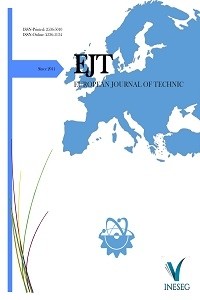EFFECTS OF SLIDING DISTANCE SPEED AND LOAD ON WEAR AND TEMPERATURE IN DIFFERENT MATRIX AND FIBER-REINFORCED COMPOSITE MATERIALS
EFFECTS OF SLIDING DISTANCE SPEED AND LOAD ON WEAR AND TEMPERATURE IN DIFFERENT MATRIX AND FIBER-REINFORCED COMPOSITE MATERIALS
Wear, , Composite Materials, Woven Fabric Polyesetr resin,
___
- [1] Vinson, J.R., Chou, T., Composite Materials and their use in structures, London, (1975).
- [2] Kishore, Sampathkumaran P., Seetharamu S., Murali A. and Kumar R.K. Journal of Reinforced Plastics and Composites.; 18(1): 55–62 (1999).
- [3] Kishore, Sampathkumaran P., Seetharamu S., Vynatheya S., Murali A. and Kumar R.K. “SEM Observations of The Effects Of Velocity and Load on The Sliding Wear Characteristics of Glass Fabric–Epoxy Composites with Different Fillers”, Wear.; 237: 20–27(2000).
- [4] A.A. Collyer, “Rubber Toughened Engineering Materials”, Chapman & Hall, London, (1994).
- [5] Pihtili, H., Tosun,N., “Effect of load and speed on the wear behaviour of woven glass fabrics and aramid fibre-reinforced composites” , Wear 252 ,; 979 -984, Elsevier (2002).
- [6] Pihtili, H., Tosun,N., “Investigation of the wear behaviour of a glass-.fibre-reinforced composite and polyester resin Composites”, Science and Technology 62; 367–370, Elsevier ( 2002).
- [7] N.S. El-Tayep, R.M. Gadelrap, “Friction and wear properties of E-glass fiber reinforced epoksi composites under different sliding contact conditions”, Wear 192,; 112-117 (1996).
- [8] N. Chand, A. Naik, S. Neogi, “Three-body abrasive wear of short glass fibre polyester composite”, Wear 242; 38–46. (2000).
- [9] M.R. Piggot, “Load-Bearing Fibre Composite”, Pergamon Press, Oxford,(1980).
- [10] S.N. Kukureka, C.J. Hooke, M. Rao, P. Liao, Y.K. Chen, “The effect of fibre reinforcement on the friction and wear af polyamide 66 under dry rolling–sliding contact”, Tribol. Int. 32,; 107–116. (1999).
- [11] V.K. Srivastava, J.P. Pathak, “Friction and wear properties of bushing bearing of graphite filled short glass fibre composite in dry sliding”, Wear 197 ,; 145–150. (1996).
- [12] ASM Handbook, ASM International. Materials Park. USA. 1992; 18.
- [13] R.Ramesh, Kishore, Rao R.M.V.G.K, “Dry sliding wear studies in glass fiber reinforced epoxy composites”, Wear, 89: 131. (1983).
- [14] Bolvari AE, Gleen SB. Eng Plast, 9:205 –15. (1996).
- [15] Halling J, ASM J. Lubr Technol, 105:212. (1983).
- [16] J. Halling, “Toward a mechanical wear equation”, J. Lubricat. Technol. Trans. ASME 105 (2) , 212–220. (1983).
- [17] K.H. Zum Gahr, “Microstructure and wear of materials”, Tribology Series, Vol. 10,Elsevier, Amsterdam, (1987).
- [18] B. Vishwanath, A.P. Verma, C.V.S. Kameswara Rao, Composite Sci. Technol. 44 (1), 77–86. (1992).
- [19] Bahadur, “Wear research and development”, J. Lubricat. Technol. Trans. ASME 100 (4),; 449–454 (1978).
- [20] N. Chand, M. Fahim, S.G. Hussain, “Effect of 60Co gamma-irradiation on interface and abrasive wear of glass-reinforced polyester composite”, J. Mater. Sci. Lett., 12,; 1603–1605. (1993).
- ISSN: 2536-5010
- Yayın Aralığı: Yılda 2 Sayı
- Başlangıç: 2011
- Yayıncı: Hibetullah KILIÇ
MODELING THE CA2+CAMKII NETWORK OF LTP IN THE JIGCELL ENVIRONMENT
PRODUCTION OF CURVED SURFACE COMPOSITES REINFORCED WITH RUBBER LAYER
Mustafa ALBAYRAK, Mete Onur KAMAN
NUMERICAL INVESTIGATION OF FATIGUE BEHAVIOURS OF NON-PATCHED AND PATCHED ALUMINIUM PIPES
Hamit ADİN, Bilal YILDIZ, Mehmet Şükrü ADİN
INVESTIGATION OF HOME TYPE HELIOSTAT SYSTEMS DAYLIGHTING PERFORMANCE WITH LIGHTING SIMULATION METHOD
ENRICHMENT OF APATITE-BEARING IRON ORE BY MAGNETIC SEPARATION AND FLOTATION
MODELING AND ANALYSIS OF PITCH ANGLE CONTROL ON VARIABLE SPEED WIND TURBINES
Hasan Bektaş PERÇİN, Abuzer ÇALIŞKAN
CLASSIFICATION OF ANALYZABLE METAPHASE IMAGES BY EXTREME LEARNING MACHINES
DESIGNING A CONTROL INTERFACE AND PID CONTROLLER OF CUK CONVERTER
DESIGN AND APPLICATION OF A SMART HOME SYSTEM BASED ON INTERNET OF THINGS
